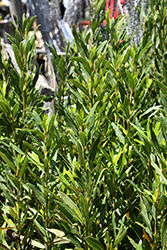It's all about ...
plants

Emerald Wave® Sweet Bay
Laurus nobilis 'Monem'
Height: 30 feet
Spread: 15 feet
Sunlight:
![]()
![]()
Hardiness Zone: 8b
Other Names: Bay Laurel, Bay Leaf
Brand: Monrovia
Description:
A robust selection, producing narrow, leathery, emerald green foliage with wavy margins, that can be used as a culinary herb; tall, pyramidal habit may be pruned to any shape and size; great as a hedge, screen, or container plant
Ornamental Features
Emerald Wave® Sweet Bay has attractive green foliage with grayish green undersides which emerges chartreuse in spring on a tree with a pyramidal habit of growth. The glossy narrow leaves are highly ornamental and remain green throughout the winter. It produces plum purple berries in early summer.
Landscape Attributes
Emerald Wave® Sweet Bay is a multi-stemmed evergreen tree with a distinctive and refined pyramidal form. Its average texture blends into the landscape, but can be balanced by one or two finer or coarser trees or shrubs for an effective composition.
This is a relatively low maintenance tree, and can be pruned at anytime. It is a good choice for attracting bees and butterflies to your yard, but is not particularly attractive to deer who tend to leave it alone in favor of tastier treats. It has no significant negative characteristics.
Emerald Wave® Sweet Bay is recommended for the following landscape applications;
- Accent
- Shade
- Hedges/Screening
- General Garden Use
- Container Planting
Planting & Growing
Emerald Wave® Sweet Bay will grow to be about 30 feet tall at maturity, with a spread of 15 feet. It has a low canopy with a typical clearance of 3 feet from the ground, and is suitable for planting under power lines. It grows at a slow rate, and under ideal conditions can be expected to live for 60 years or more. This is a dioecious species, meaning that individual plants are either male or female. Only the females will produce fruit, and a male variety of the same species is required nearby as a pollinator.
This tree does best in full sun to partial shade. It does best in average to evenly moist conditions, but will not tolerate standing water. It is not particular as to soil type or pH. It is somewhat tolerant of urban pollution. This is a selected variety of a species not originally from North America. It can be propagated by cuttings; however, as a cultivated variety, be aware that it may be subject to certain restrictions or prohibitions on propagation.
Emerald Wave® Sweet Bay is a fine choice for the yard, but it is also a good selection for planting in outdoor pots and containers. Its large size and upright habit of growth lend it for use as a solitary accent, or in a composition surrounded by smaller plants around the base and those that spill over the edges. It is even sizeable enough that it can be grown alone in a suitable container. Note that when grown in a container, it may not perform exactly as indicated on the tag - this is to be expected. Also note that when growing plants in outdoor containers and baskets, they may require more frequent waterings than they would in the yard or garden. Be aware that in our climate, most plants cannot be expected to survive the winter if left in containers outdoors, and this plant is no exception. Contact our experts for more information on how to protect it over the winter months.
This plant is not reliably hardy in our region, and certain restrictions may apply; contact the store for more information.

